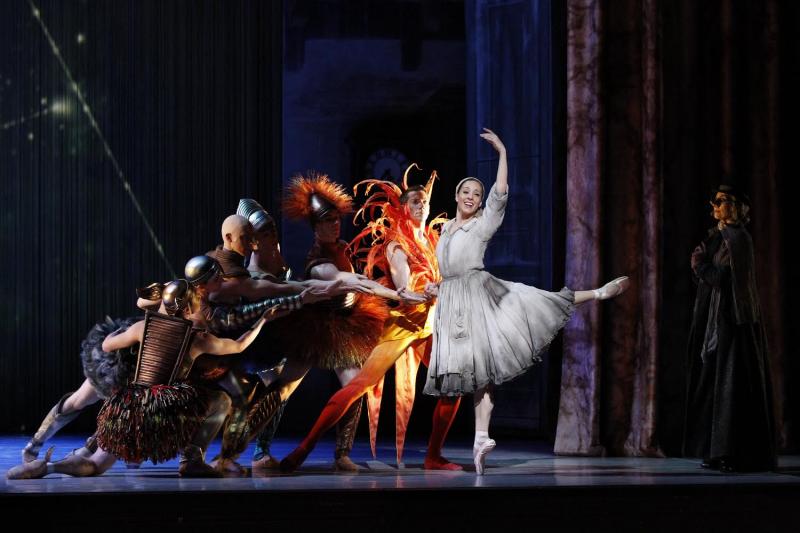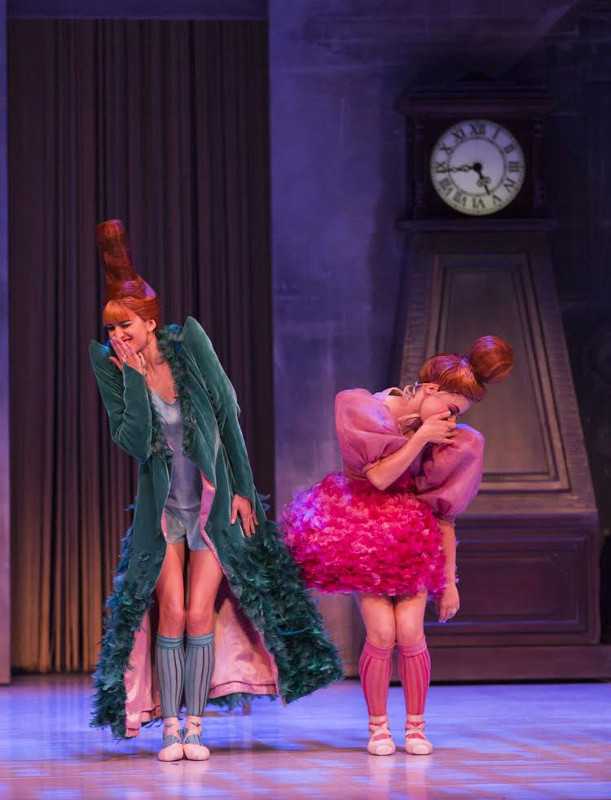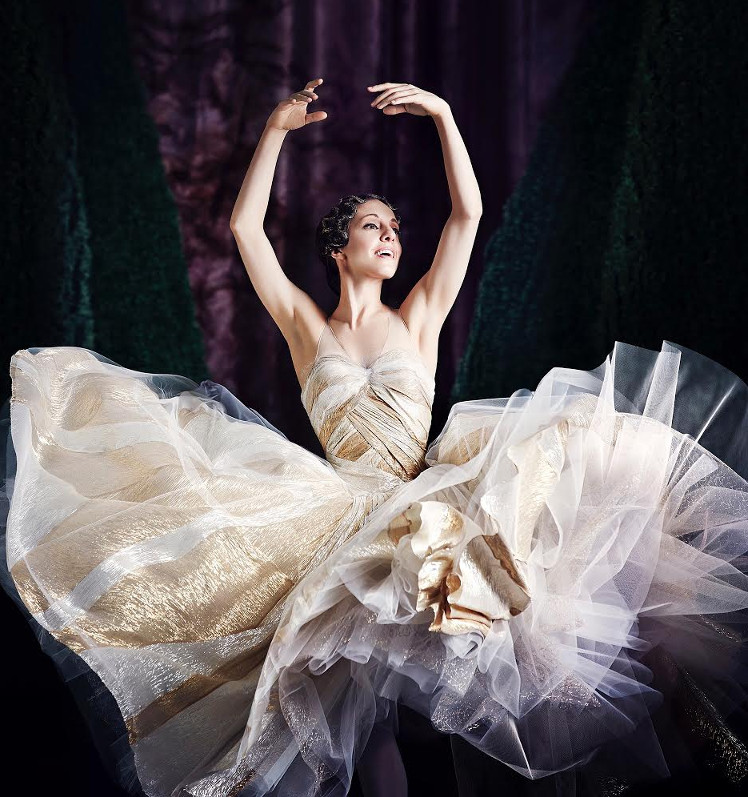Cinderella, Ratmansky/Australian Ballet, London Coliseum | reviews, news & interviews
Cinderella, Ratmansky/Australian Ballet, London Coliseum
Cinderella, Ratmansky/Australian Ballet, London Coliseum
Serious choreography and lush design make this Surrealist fairytale a visual treat

Does Alexei Ratmansky, former Bolshoi director and current world-leading classical choreographer, really love Prokofiev's Cinderella, or did he choose to create a new one for Australian Ballet in 2013 principally because he wasn't happy with his first (for the Mariinsky) in 2002?
 It's (mostly) an improvement. Though I remain an apologist for the harshness in the Mariinsky Cinderella, which picks up on the score's strident, sardonic qualities (it was composed in the early 1940s) and confronts the cruelty and dinginess of the tite character's life head-on, it is burdened by undeniably hideous costumes and choreography that never quite seems to get going. The Australian version, on the other hand, is a visual treat, especially in costume: clever sculptural outfits exaggerate the ugly sisters' traditional characterisations (Skinny and Dumpy) so that one is dressed as a cylinder, the other as a sphere (pictured right). The planets which appear instead of seasons in Act I (a brilliant conceit) have delightful ball-shaped tutus in a range of earthy metallic tones (main picture); the ball guests are dashing in mauve and sage velvet tuxedos; Cinders gets to wear gorgeous smoke-grey chiffon at home and white tulle with gold lamé at the ball. Even the Stepmother is spared the usual mutton-dressed-as-lamb treatment and given instead a snappy magenta outfit complete with joke-enormous but seriously gorgeous fur cloak.
It's (mostly) an improvement. Though I remain an apologist for the harshness in the Mariinsky Cinderella, which picks up on the score's strident, sardonic qualities (it was composed in the early 1940s) and confronts the cruelty and dinginess of the tite character's life head-on, it is burdened by undeniably hideous costumes and choreography that never quite seems to get going. The Australian version, on the other hand, is a visual treat, especially in costume: clever sculptural outfits exaggerate the ugly sisters' traditional characterisations (Skinny and Dumpy) so that one is dressed as a cylinder, the other as a sphere (pictured right). The planets which appear instead of seasons in Act I (a brilliant conceit) have delightful ball-shaped tutus in a range of earthy metallic tones (main picture); the ball guests are dashing in mauve and sage velvet tuxedos; Cinders gets to wear gorgeous smoke-grey chiffon at home and white tulle with gold lamé at the ball. Even the Stepmother is spared the usual mutton-dressed-as-lamb treatment and given instead a snappy magenta outfit complete with joke-enormous but seriously gorgeous fur cloak.
The dissonance of the score is rendered visually through oddness, rather than ugliness, Jerôme Kaplan and Ratmansky used Surrealist art with its skewed proportions and misplaced objects to convey the subtly off-key, magical reality that Cinderella inhabits: it is inspired to have Dalí's clock faces and Man Ray's metronome appear at key moments in this clock-obsessed ballet, though Dalí's "Mae West" sofa is rather too iconic to be plausible in Cinderella's house. Digital animations of planets and weather add brilliant touches of whimsy in the background, but the big ones used as temporary front cloths for the world journey sequence looked flat and jarring against the sculptural shapes and muted mid-century colours of the rest of the design.
 The most satisfying visual, however, is the choreography itself. We in the UK haven't seen as much of Ratmansky as we would like, and certainly not his story ballets: this Cinderella brings home in a most satisfying way the quality of Ratmansky's mature style. The cross-currents, the stretched and twisted positions, the jokey and jazzy elements of the Mariinsky work (his first full-length ballet) are still there, and some are even directly quoted, but they are strung together much more fluently. Where in the former work, dance numbers were fragmented and cut short, here Ratmansky seems to luxuriate in the music, taking the various romantic waltzes of Act II and the final pas de deux of Act III at a spacious tempo that allows the dancers to get deep into pliés and backbands. This is very much not a soaring ballet, but a grounded one; jumps are, by and large, the low, fluttering, precise ones of petit allegro. It's in these petit allegro sequences that Ratmansky's nature as a dancer's choreographer is clearest: he is a real master of classical ballet's grammar as well as its style, and his work has a density and substance to it that, for example, Graeme Murphy's Swan Lake last week lacked. It may still be too early to compare Ratmansky to Balanchine, but the similarities are there, and not purely attributable to Ratmansky having absorbed Mr B's style during his time in New York.
The most satisfying visual, however, is the choreography itself. We in the UK haven't seen as much of Ratmansky as we would like, and certainly not his story ballets: this Cinderella brings home in a most satisfying way the quality of Ratmansky's mature style. The cross-currents, the stretched and twisted positions, the jokey and jazzy elements of the Mariinsky work (his first full-length ballet) are still there, and some are even directly quoted, but they are strung together much more fluently. Where in the former work, dance numbers were fragmented and cut short, here Ratmansky seems to luxuriate in the music, taking the various romantic waltzes of Act II and the final pas de deux of Act III at a spacious tempo that allows the dancers to get deep into pliés and backbands. This is very much not a soaring ballet, but a grounded one; jumps are, by and large, the low, fluttering, precise ones of petit allegro. It's in these petit allegro sequences that Ratmansky's nature as a dancer's choreographer is clearest: he is a real master of classical ballet's grammar as well as its style, and his work has a density and substance to it that, for example, Graeme Murphy's Swan Lake last week lacked. It may still be too early to compare Ratmansky to Balanchine, but the similarities are there, and not purely attributable to Ratmansky having absorbed Mr B's style during his time in New York.
Ratmansky's production is as close to well-balanced as this sweet 'n' sour fairytale gets
Having seen Australian Ballet twice in a week now, I'm beginning to form a picture of their house style. It stresses prettiness and charm in acting, and years of good work have gone into producing the soft arms and expressive hands that practically every dancer deploys to good effect. There are a number of dancers with gorgeous feet, but very few who routinely finish jumps and turns cleanly, and the corps work was a little messy in both performances I saw. Still, it's an engaging package overall, and for something like Cinderella, smooth charm works very well. There isn't too much character development in either Leanne Stojmenov's Cinderella or Kevin Jackson's Prince, but both imbue their characters with genuine personality, and Stojmenov (pictured above left) in particular is a charming lead, playing Cinders in the best tradition of loveable Aussie girls-next-door (see: Kylie Minogue).
Act III verges on the long side, what with the prince going on his round-the-world journey including temptations of the male and female variety (both rather tacky; best skipped over) and a long final pas de deux: the story's urgency dissipates, and the pas de deux doesn't have the climactic quality that sends other fairy-tale ballets out on a high (Nutcracker, Sleeping Beauty etc). But too much Ratmansky is a good problem to have, and even in its occasional longeurs this Cinderella is brilliantly easy on the eye. I regret the loss of some of the Mariinsky Cinderella's sharpness, but on his second try Ratmansky has got almost as close to well-balanced as this sweet 'n' sour fairytale gets.
- The Australian Ballet perform Cinderella at the London Coliseum until 23 July. Three of the company's fairy tale ballets, including Cinderella, will be broadcast live to cinemas worldwide in October 2016.
- Read more dance reviews on theartsdesk
rating
Explore topics
Share this article
The future of Arts Journalism
You can stop theartsdesk.com closing!
We urgently need financing to survive. Our fundraising drive has thus far raised £49,000 but we need to reach £100,000 or we will be forced to close. Please contribute here: https://gofund.me/c3f6033d
And if you can forward this information to anyone who might assist, we’d be grateful.

Subscribe to theartsdesk.com
Thank you for continuing to read our work on theartsdesk.com. For unlimited access to every article in its entirety, including our archive of more than 15,000 pieces, we're asking for £5 per month or £40 per year. We feel it's a very good deal, and hope you do too.
To take a subscription now simply click here.
And if you're looking for that extra gift for a friend or family member, why not treat them to a theartsdesk.com gift subscription?
more Dance
 'We are bowled over!' Thank you for your messages of love and support
Much-appreciated words of commendation from readers and the cultural community
'We are bowled over!' Thank you for your messages of love and support
Much-appreciated words of commendation from readers and the cultural community
 iD-Reloaded, Cirque Éloize, Marlowe Theatre, Canterbury review - attitude, energy and invention
A riotous blend of urban dance music, hip hop and contemporary circus
iD-Reloaded, Cirque Éloize, Marlowe Theatre, Canterbury review - attitude, energy and invention
A riotous blend of urban dance music, hip hop and contemporary circus
 How to be a Dancer in 72,000 Easy Lessons, Teaċ Daṁsa review - a riveting account of a life in dance
Michael Keegan-Dolan's unique hybrid of physical theatre and comic monologue
How to be a Dancer in 72,000 Easy Lessons, Teaċ Daṁsa review - a riveting account of a life in dance
Michael Keegan-Dolan's unique hybrid of physical theatre and comic monologue
 A Single Man, Linbury Theatre review - an anatomy of melancholy, with breaks in the clouds
Ed Watson and Jonathan Goddard are extraordinary in Jonathan Watkins' dance theatre adaptation of Isherwood's novel
A Single Man, Linbury Theatre review - an anatomy of melancholy, with breaks in the clouds
Ed Watson and Jonathan Goddard are extraordinary in Jonathan Watkins' dance theatre adaptation of Isherwood's novel
 Peaky Blinders: The Redemption of Thomas Shelby, Rambert, Sadler's Wells review - exciting dancing, if you can see it
Six TV series reduced to 100 minutes' dance time doesn't quite compute
Peaky Blinders: The Redemption of Thomas Shelby, Rambert, Sadler's Wells review - exciting dancing, if you can see it
Six TV series reduced to 100 minutes' dance time doesn't quite compute
 Giselle, National Ballet of Japan review - return of a classic, refreshed and impeccably danced
First visit by Miyako Yoshida's company leaves you wanting more
Giselle, National Ballet of Japan review - return of a classic, refreshed and impeccably danced
First visit by Miyako Yoshida's company leaves you wanting more
 Quadrophenia, Sadler's Wells review - missed opportunity to give new stage life to a Who classic
The brilliant cast need a tighter score and a stronger narrative
Quadrophenia, Sadler's Wells review - missed opportunity to give new stage life to a Who classic
The brilliant cast need a tighter score and a stronger narrative
 The Midnight Bell, Sadler's Wells review - a first reprise for one of Matthew Bourne's most compelling shows to date
The after-hours lives of the sad and lonely are drawn with compassion, originality and skill
The Midnight Bell, Sadler's Wells review - a first reprise for one of Matthew Bourne's most compelling shows to date
The after-hours lives of the sad and lonely are drawn with compassion, originality and skill
 Ballet to Broadway: Wheeldon Works, Royal Ballet review - the impressive range and reach of Christopher Wheeldon's craft
The title says it: as dancemaker, as creative magnet, the man clearly works his socks off
Ballet to Broadway: Wheeldon Works, Royal Ballet review - the impressive range and reach of Christopher Wheeldon's craft
The title says it: as dancemaker, as creative magnet, the man clearly works his socks off
 The Forsythe Programme, English National Ballet review - brains, beauty and bravura
Once again the veteran choreographer and maverick William Forsythe raises ENB's game
The Forsythe Programme, English National Ballet review - brains, beauty and bravura
Once again the veteran choreographer and maverick William Forsythe raises ENB's game
 Sad Book, Hackney Empire review - What we feel, what we show, and the many ways we deal with sadness
A book about navigating grief feeds into unusual and compelling dance theatre
Sad Book, Hackney Empire review - What we feel, what we show, and the many ways we deal with sadness
A book about navigating grief feeds into unusual and compelling dance theatre
 Balanchine: Three Signature Works, Royal Ballet review - exuberant, joyful, exhilarating
A triumphant triple bill
Balanchine: Three Signature Works, Royal Ballet review - exuberant, joyful, exhilarating
A triumphant triple bill

Add comment